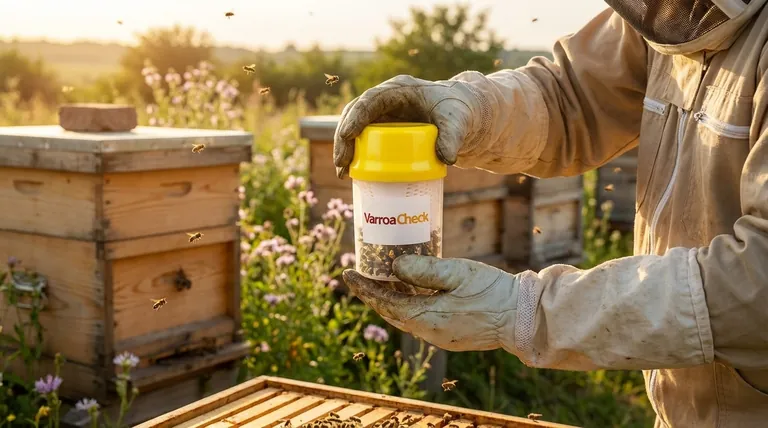The recommended mite level threshold for beekeepers is not a single number, but a dynamic target that changes with the season. To prevent significant colony losses, you should aim to keep Varroa mite levels below 1% (1 mite per 100 bees) in the spring and below 3% (3 mites per 100 bees) in the late summer and fall.
The core principle is not to simply react to a number, but to use these thresholds as triggers for proactive management. Maintaining low mite levels throughout the year, especially before the bee population contracts for winter, is the single most critical factor in ensuring colony survival.

Why Mite Thresholds Are Your Most Critical Metric
Effective management of Varroa destructor mites is essential for any beekeeper. These thresholds serve as your early warning system, allowing you to intervene before an infestation becomes catastrophic and leads to colony collapse.
The Spring Threshold: Below 1%
In the spring, the honeybee colony is in a period of rapid expansion. The goal is to start with the lowest possible mite count.
Keeping the infestation rate below 1 mite per 100 bees ensures that the mite population does not explode in tandem with the growing bee population. A low starting point is your best defense for the entire season.
The Fall Threshold: Below 3%
As the season transitions into fall, the bee population begins to shrink in preparation for winter. This is a period of heightened risk.
The bees raised in the fall are the "winter bees" that must survive for months. A mite infestation of 3% (3 mites per 100 bees) at this stage is a critical action threshold. Treating at this level is necessary to protect the health and longevity of your vital winter colony.
The Universal "Danger Zone": 3%
Some sources suggest a general action threshold of 3% at any point during the season. This is a sound, conservative approach.
If your monitoring ever reveals an infestation at or above 3%, you should consider it an immediate signal to take corrective action, regardless of the time of year.
Understanding the Trade-offs and Pitfalls
Simply knowing the numbers is not enough. Misinterpreting their purpose can lead to a false sense of security and devastating losses.
Thresholds are Triggers, Not Goals
The objective is to keep mite levels as low as possible at all times. The 1% and 3% figures are not targets to aim for; they are upper limits that signal an urgent need for treatment.
The Danger of Inaction
Ignoring these thresholds allows the mite population to spiral out of control. This not only weakens bees directly by feeding on them but also transmits deadly viruses throughout the colony, dramatically reducing its chance of surviving the winter.
Monitoring is Non-Negotiable
These thresholds are useless without consistent and accurate monitoring. Regular testing, such as an alcohol wash or a powdered sugar roll, is the only way to know your colony's actual infestation level and make informed management decisions.
Applying Thresholds to Your Beekeeping Calendar
Your management strategy should be guided by your colony's annual cycle. Use these thresholds to decide when and how to act.
- If your primary focus is early-season growth: Your goal is aggressive prevention; aim to keep mite levels well below the 1% threshold to ensure a healthy population boom.
- If your primary focus is winter survival: You must intervene if mite levels approach the 3% threshold in late summer or fall to protect the health of your winter bees.
- If you are new to beekeeping: Treat the 3% threshold as your absolute maximum at any time of year and prioritize learning a consistent mite monitoring method.
Proactive monitoring and respecting these thresholds are the cornerstones of responsible and successful beekeeping.
Summary Table:
| Season | Recommended Threshold | Key Objective |
|---|---|---|
| Spring | Below 1% (1 mite/100 bees) | Prevent mite population explosion during colony expansion. |
| Late Summer / Fall | Below 3% (3 mites/100 bees) | Protect the health of winter bees for colony survival. |
| General 'Danger Zone' | 3% or above | Immediate action required at any time of year. |
Protect your apiary's health and profitability with the right equipment. Consistent monitoring and timely treatment are essential for managing Varroa mite levels. HONESTBEE supplies commercial apiaries and beekeeping equipment distributors with the high-quality, wholesale-focused supplies needed for effective mite control and overall hive health. Let's discuss your needs — contact our team today to ensure your operation is equipped for success.
Visual Guide

Related Products
- Varroa Easy Check Mite Tester Kit Counter Alcohol Wash Jar
- High Performance Plastic Queen Excluder for Beekeeping and Apiary Management
- Professional Plastic Queen Excluder for Modern Beekeeping
- Metal Queen Bee Excluder for Beekeeping
- Premium Wood Framed Metal Wire Queen Bee Excluder
People Also Ask
- Why is an alcohol wash preferred over powdered sugar rolls? For Accurate Varroa Mite Management
- How is the infestation percentage calculated after counting mites? Master Varroa Mite Monitoring
- What is the most accurate method for monitoring varroa mites? The Definitive Guide for Beekeepers
- What is the Varroa EasyCheck and its purpose? Streamline Your Hive Health Monitoring
- How often should varroa mite checks be performed using the alcohol wash method? Optimize Your Apiary's Health



















